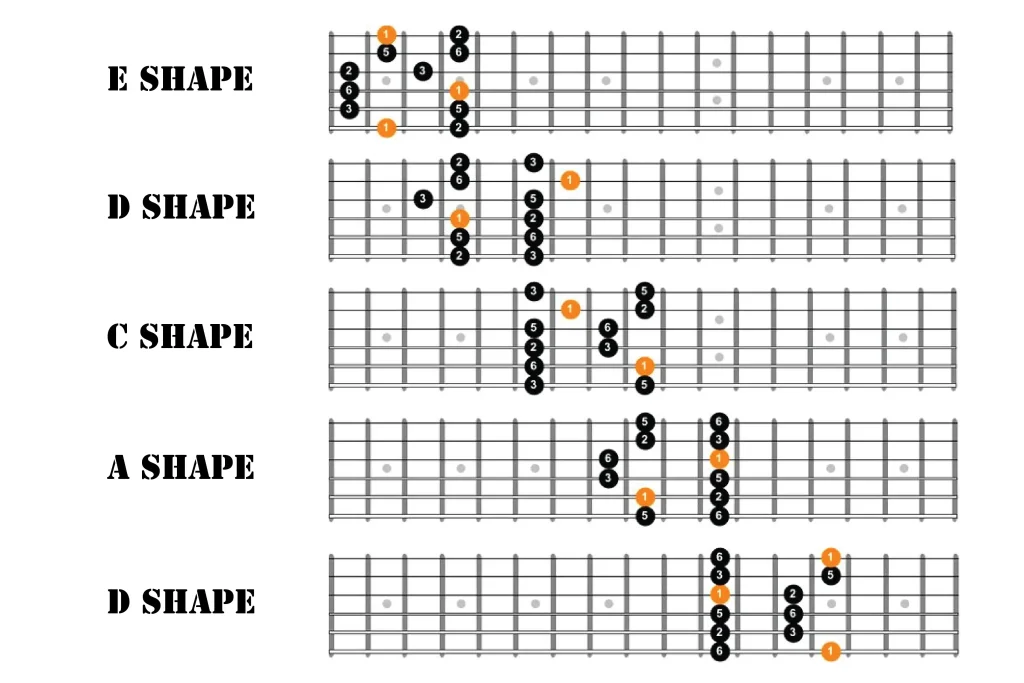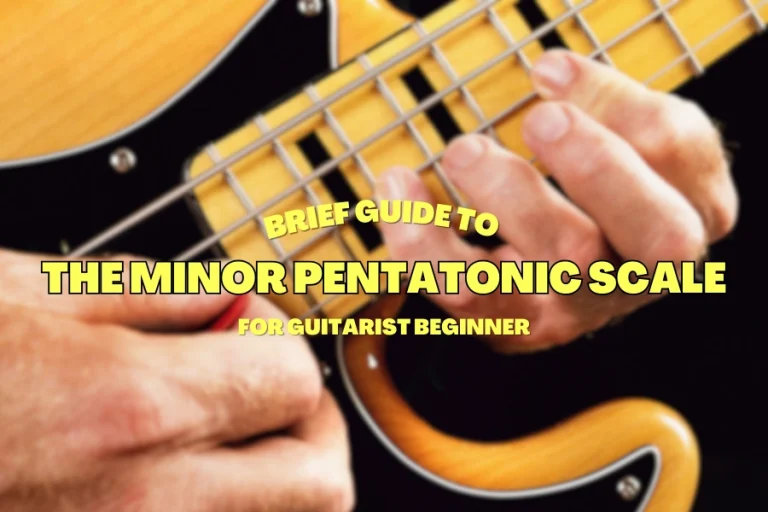
When it comes to the great tools to create any unique guitar solos, the major pentatonic scale always stands first by its simplicity in construction. Its ability to produce iconic sounds and melodies makes this scale a foundation for a diverse range of musical genres, including rock, blues to country music. Therefore, most guitarists are always eager to master this useful scale.
However, without a deep passion for guitar, it’s easy for you to lose motivation in the learning process. In order to master this technique, we’ll walk you through the five basic principles and show how it guides you in your journey!
What Is The Major Pentatonic Scale?
The Greek terms “pente” (meaning “five”) and “tonic” (meaning “notes”) are the sources of the word “Pentatonic”. Therefore, the major pentatonic scale consists of five notes: the root, 2nd, 3rd, 5th, and 6th degrees of the major scale, excluding the 4th and 7th degrees. People often confuse the difference between the five-tone scale and its minor counterpart. The 5-note scale has a bright, uplifting quality, while the minor pentatonic scale leans toward a more bluesy or melancholic tone.
Creating a major pentatonic scale is quite simple. By leaving out the 4th and 7th notes on the major scale, you’ll have the five-note scale. This music theory allows you to generate numerous major pentatonic that produce bright and uplifting sounds while steering clear of any dissonance. Here is an example:
C Major Scale: C D E F G A B
C Major Pentatonic Scale: C D E G A
The major pentatonic scale can be applied across many musical genres, shaping melody compositions and guitar solos that sound harmonious over various chord progressions. Here is why it enables musicians to create sounds that pleasing the ear, making it the optimal choice for music composition.

The pentatonic scale does not include any semitones. This is because the 4th and 7th intervals are excluded from the pentatonic scale. The absence of semitones is a big reason why this scale always produces pleasant and smooth sounds. Its unique structure gives it a special appeal, allowing artists to cultivate their distinctive sound without following any specific standards by adopting this scale.
Many famous guitarists have incorporated the major pentatonic scale into their work. For instance, you can watch BB King’s legendary solo during his 1986 performance of “Nobody Loves Me But My Mother” in Sweden. The first two minutes of his solo showcase concepts rooted in this major five-tone scale, demonstrating how this scale can be used to craft soulful, expressive music. This performance also highlights the scale’s ability to shine in professional compositions, inspiring musicians across genres.
Top 5 Essential Major Pentatonic Scale Shapes On The Guitar
There are 5 common visual shapes, often known as the CAGED system, which helps you better comprehend how the major pentatonic scale actually works across the guitar fretboard.

The E Shape
The E major pentatonic scale includes red dots indicating the root notes, and the numbers indicate the intervals of the other notes relative to the root. Guitarists typically use the thinnest two strings with their 2nd and 4th fingers in order to gain better control over the notes.
This shape appears in genres like in blues, folk, country and pop music. Some notable pieces that feature the E major pentatonic scale include Paramore’s “Ain’t It Fun” with its striking scale or Green Day’s “Basket Case”, an alt-punk classic.
The D Shape
To play the D five-note scale well, it’s ideal to use your 1st and 3rd fingers. However, if you find it more comfortable, you can switch to using your 1st and 4th fingers on the G and B strings. This adaptability allows you to explore a wider range of sounds and create diverse melodies. If you want to research D shape further, a great example of this shape is James Burton’s performance named “It’s up to You”, produced by Rick Nelson.
The C Shape
When practicing the C pentatonic scale, try using your 1st and 3rd fingers to play two notes on the 2nd string. While this scale can be more tricky than the D and E shapes, the consistent effort you invest will pay off.
The A Shape
When playing the A pentatonic scale, it’s recommended to use your 1st and 3rd fingers for all the notes. This finger positioning allows for better control and smoother transitions between the notes. When you reach the middle strings, you might find it easier to switch to your 1st and 4th fingers. Although it may seem difficult at first, this shape offers endless opportunities for creating rich melodies if you sincerely take the time to explore it.
The G Shape
The G scale shape is the most accessible shape to begin within the CAGED system in music theory. For the notes on the 1st and 2nd strings, I recommend you to utilize your 3rd finger. This shape serves as a great foundation for developing your fingers’ flexibility adapting to the notes.
Advice For Beginners To Learn Scale Tutorials
Here are some useful tips to make your guitar practice sessions more effective and reduce the likelihood of mistakes:
- Practice slowly and correctly: If you always hurry, you may get discouraged due to the number of mistakes you make. It’s necessary to allocate plenty of time to practicing rather than rushing yourself through it. As a result, you will develop a good feel for the notes and improve finger agility.
- Use your fingertips: During the playing process, you must ensure that you’re pressing your fingertips without letting your fingers “fold” at any point.
- Begin and conclude your practice on the lowest root note: This approach not only enhances your familiarity with the scale’s structure but also helps train your ear, which is a crucial skill for beginners.
- Develop skills step by step: By beginning with the simplest scale shapes, you allow your fingers to get used to the necessary movements. As you gain comfort and confidence with these foundational patterns, you’ll find it much easier to tackle more intricate scales and techniques.
Final thought
After reading this article, you should be ready to practice the major pentatonic scale using the appropriate strategies. Whether you’re composing melodies or improvising solos, consistent practice will help you integrate this versatile scale into your musical repertoire seamlessly. With the right approach and commitment provided in this article, you’ll soon be proficient in pentatonic scale techniques.









